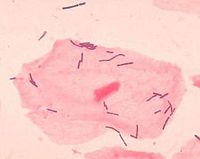Lactobacillus plantarum: Difference between revisions
imported>Jennifer Yoon No edit summary |
imported>Jennifer Yoon |
||
| Line 29: | Line 29: | ||
<gallery> | <gallery> | ||
Image:Cheese plate.jpg|Cheese | Image:Cheese plate.jpg|Cheese | ||
Image:Kimchee.jpg|Kimchee | |||
Image:GI Tract.jpg|Human GI Tract | Image:GI Tract.jpg|Human GI Tract | ||
</gallery> | </gallery> | ||
Revision as of 16:59, 22 April 2009
For the course duration, the article is closed to outside editing. Of course you can always leave comments on the discussion page. The anticipated date of course completion is May 21, 2009. One month after that date at the latest, this notice shall be removed. Besides, many other Citizendium articles welcome your collaboration! |
 | ||||||||||||||
| Scientific classification | ||||||||||||||
| ||||||||||||||
| Binomial name | ||||||||||||||
Genome structure
In 2003, Michiel Kleerebezem mapped out the complete genome of Lactobacillus plantarum WCFS1. Lactobacillus plantarum strain WCFS1 is known to have 3,308,274 base pairs and contains 3,052 protein-encoding genes as well as three plasmids (1,917-bp, 2,365-bp, and 36,069-bp,) which accounts for its high adaptability. The G+C content of the chromosome is 44.5%, but the plasmids contain slightly less G+C content. 1
Cell structure and metabolism
Lactobacillus plantarum is a gram positive, rod-shaped, organotrophic, bacteria often called lactic acid bacteria because it gets most of its energy from converting glucose to lactate via homolactic and heterolactic fermentation. Homolactic fermentation uses the EMP pathway and heterolactic fermentation uses the phosphoketolase pathway. Therefore, L. plantarum is a facultative heterofermentative lactobacilli. 2 1
Ecology
Lactobacillus plantarum is a highly adaptive bacteria that can survive at temperatures between 10º to 60º Celsius. L. plantarum is found in fermented foods including yogurt, cheese, kim chee and is also found in animal GI tracts, human saliva, and plants. 3 4 1
Pathology
Lactobacillus plantarum 299v is actually considered to be a probiotic. Due to its ability to survive in the human GI tract for >6 days, L. plantarum 299v can inhibit the growth of other harmful bacteria such as E. coli in the host after contaminated meat consumption. L. plantarum 299v is found in various fermented foods such as yogurt, cheese, kim chee, and is recommended to be consumed regularly to support the immune system. In addition, the ability of L. plantarum 299v to produce lactic acid helps maintain healthy, low pH levels of the GI tract. 1 3 4
Applications to Biotechnology
In 2004, Jean-Marie Perrier-Cornet discovered a way to control food fermentation by using Lactobacillus plantarum. A cold pasteurization method without freezing the food is a new technology for the food industry. Perrier-Cornet found optimization of the procedure when pasteurizing L. plantarum for 10 min at temperatures between −20 and 25 °C and pressure between 100 and 350 MPa. 5
Current Research
In 2006, Michael Schultz studied the effects of treatment with Lactobacillus plantarum on immunodeficient mice prone to the development of colitis. The study found that L. plantarum administered orally with water to interleukin-10-deficient mice produced significant results of reduced immune-mediated colitis. This suggests that L. plantarum has the potential to be used against clinical inflammatory bowel diseases. 6
References
- Michiel Kleerebezem, Jos Boekhorst, Richard van Kranenburg, Douwe Molenaar, Oscar P. Kuipers, Rob Leer, Renato Tarchini, Sander A. Peters, Hans M. Sandbrink, Mark W. E. J. Fiers, Willem Stiekema, René M. Klein Lankhorst, Peter A. Bron, Sally M. Hoffer, Masja N. Nierop Groot, Robert Kerkhoven, Maaike de Vries, Björn Ursing, Willem M. de Vos*, and Roland J. Siezen. (2003). Complete genome sequence of Lactobacillus plantarum WCFS1. Proceedings of the National Academy of Sciences, 100 (4), 1990-1995.
- http://microbewiki.kenyon.edu/index.php/Lactobacillus
- http://www.ebi.ac.uk/2can/genomes/bacteria/Lactobacillus_plantarum.html
- http://lwicker.myweb.uga.edu/kimchee.htm
- Jean-Marie Perrier-Cornet, Sandra Tapin, Serenella Gaeta and Patrick Gervais. (2004). High-pressure inactivation of Saccharomyces cerevisiae and Lactobacillus plantarum at subzero temperatures. Journal of Biotechnology, 115 (4), 405-412.
- Michael Schultz , Claudia Veltkamp , Levinus A. Dieleman , Wetonia B. Grenther , Pricilla B. Wyrick , Susan L. Tonkonogy , R. Balfour Sartor, M.D. (2006). Lactobacillus plantarum 299V in the treatment and prevention of spontaneous colitis in interleukin-10-deficient mice. Wiley Interscience, 8 (2), 71-80


